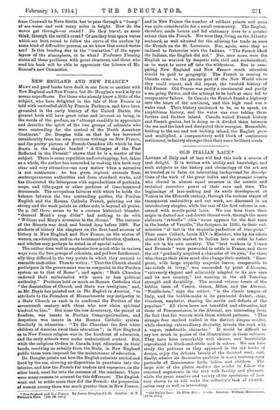OLD ITALIAN LACE.*
LOVERS of Italy and of lace will find this book a source of real delight. It is written with ability and knowledge, and such subjects as the history and chronology of the ar•t are so treated as to form an interesting background for descrip- tions of the work of the great ladies and the peasant women who shared in almost equal measure in the artistic and technical executive power of their race and time. The beginnings of lace-making and its swift development at Venice in the fifteenth century, through the various stages of transparent embroidery and cut work, are discussed in an introductory chapter, while the rest of the first volume is con- cerned with needle-point laces. We can here trace their origin in darned-net and drawn-thread work, through the more elaborate " reticella" (this "name appears for the first time in the books of Vecellio," the designer, in 1591), to their cul- mination "at last in the exquisite perfection of rose•point" Then came Colbert, Louis XIV.'s Minister, who by his edicts closed the French market to Italian lace in order to footer the art in his own country. The "best workers in Venice and Brussels" were persuaded to settle in France, and there the art "gradually acquired a character of its own," for those who change their skies must also change their outlook. "Rose- point, with large superbly majestic leaves, comparable to bas-reliefs in ivory," was succeeded by point d'Alencon, "extremely elegant and admirably adapted to its new uses and its new country," but wanting in the old Venetian strength and durability. The second volume treats of the bobbin laces of Venice, Genoa, Milan, and the Abruzzi. "Needle-lace," says the author, "is the classic tongue of Italy, and the bobbin-make is its provincial dialect, clear, vivacious, emphatic, sharing the merits and defects of the populace." All these laces are beautiful and attractive, but those of Pescocostanzo, in the Abruzzi, are interesting from the fact that the women work them without patterns. " This strange free method (called in the district disegno sciolio), while showing extraordinary dexterity, invests the work with a vague, indefinable character." It would be difficult to say too much in praise of the illustrations in these volmnee. They have been remarkably well chosen, and beautifully reproduced in black-and-white and in colour. We can hero
study the patterns as they appeared in the old books of design, enjoy the delicate beauty of the finished work, and, finally, admire its decorative qualities in many contemporary portraits of Renaissance lords, ladies, and children. The large size of the plates enables the reader to follow the reasoned arguments in the text with facility and pleasure, while the great number and variety of the specimens of lace here shown to us will make the collector's task of identifi- cation easy as well as interesting.
• Otd Dalian Lace. By Bliss Ricci. 2 vole. London: William, Hainsuaaoa.
[CO Os. sot] •






































 Previous page
Previous page